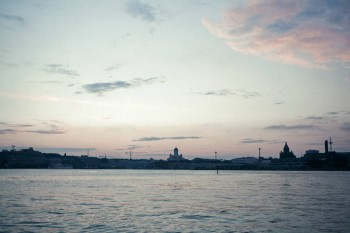Life is
16 February 2012 | Letter from the Editors

Helsinki silhouette. Photo: Valtteri Hirvonen, Eriksson&Company / World Design Capital Helsinki, 2011
Where is Books from Finland located?
In the old days, the answer was simple, although not unambiguous. Books came from its office in central Helsinki; it was written in various locations in Finland and abroad, and translated mainly in England and the United States; and it was published in the small town of Vammala, about 200 kilometres north of Helsinki.
It spread, in multiple paper copies, to readers throughout the world, to find its place on desks, on bedside tables, in briefcases and handbags, propping up table-legs or holding doors open – in London, England, Connecticut, New England, with a few in Paris, France, and Paris, Texas, maybe.
Nowadays, it’s different. It’s hard to say exactly where Books from Finland comes from. Our offices are still in central Helsinki, although now we can edit it with ease from wherever we happen to be; our writers and translators live and work where they have always lived and worked. Our readers – more and more of them now, through the open access of the internet – still hail from the world over. Books from Finland makes an appearance on your computer screen, or your smartphone. But Books itself exists, in the last analysis, on a server in some shuttered and air-conditioned room whose location is hotly disputed online but is probably somewhere in California.
But we, along with Books from Finland, are still small-town kids at heart. Small-country kids, too, of course. And – partly prompted by Helsinki’s new status, this year, as World Design Capital – we’ve been giving some thought to our home city and the part it plays in our lives and work.
Just over a decade ago, we edited a little book called Helsinki: A Literary Companion (Finnish Literature Society, 2000; still available, with some luck, from internet booksellers). It was an project that developed, as we said in our foreword, ‘over countless conversations as we walked through Helsinki’s streets to meetings with authors or designers, argued and discussed literature, the arts and politics… in the city’s cafés and bars, or, we admitted somewhat ruefully, ‘allowed ourselves a little post-deadline indulgence in its shops’. We charted its development from its foundation by the Swedish crown in 1650 and its transformation into the country’s capital after Finland was annexed by Russia in 1809, to the end of the 20th century.
From the beginning, then, Helsinki has been a planned city; there’s nothing organic about the way it’s grown. Nothing wrong with that, you may say, and the sheer beauty of its architecture – from Carl Ludvig Engel’s delicately monumental early 19th-century centre to the classics of the Finnish art nouveau movement that decorate its streets, and on to Alvar Aalto’s dreamy white Finlandia Hall and the most recent additions of Kiasma, the museum of contemporary art, and the new concert hall in the heart of the city – is a powerful argument for centralised planning.
Sometimes, though, it feels as if Helsinki has struggled to achieve the sheer diversity and spontaneity of more chaotic cities elsewhere. But in the twelve years since we published the Literary companion, much has changed. The street scene is more varied, with cafés, bars and restaurants for every pocket; the shops stay open late, and new areas of old industrial sites are being transformed for various purposes. What used sometimes to feel a little like a ghost city, beautiful but empty, is now thronged with people, day and night, and people-watching is a major sport.
One thing remains the same: as we noted back on the brink of the new millennium, Helsinki’s compactness gives it a focus, and an edge, that other cities sometimes lack. In a place where you can expect to see most of the people you might work with in the street, plans are built concretely on human relationships – real, not virtual – and where people get together, all sorts of things can happen.
In other words, however squeaky-clean the designers’ plans may sometimes have a way of sounding, things usually turn out a little differently, and not always for the worse. Human beings, and human nature, will always intervene to complicate them. Elämä on, as we say; life is, and it rarely goes according to plan. Happily so; for it is the vagaries of human life, and not its regularities, that give rise to our subject, literature.
Tags: design, Helsinki, history, publishing, writing
No comments for this entry yet
